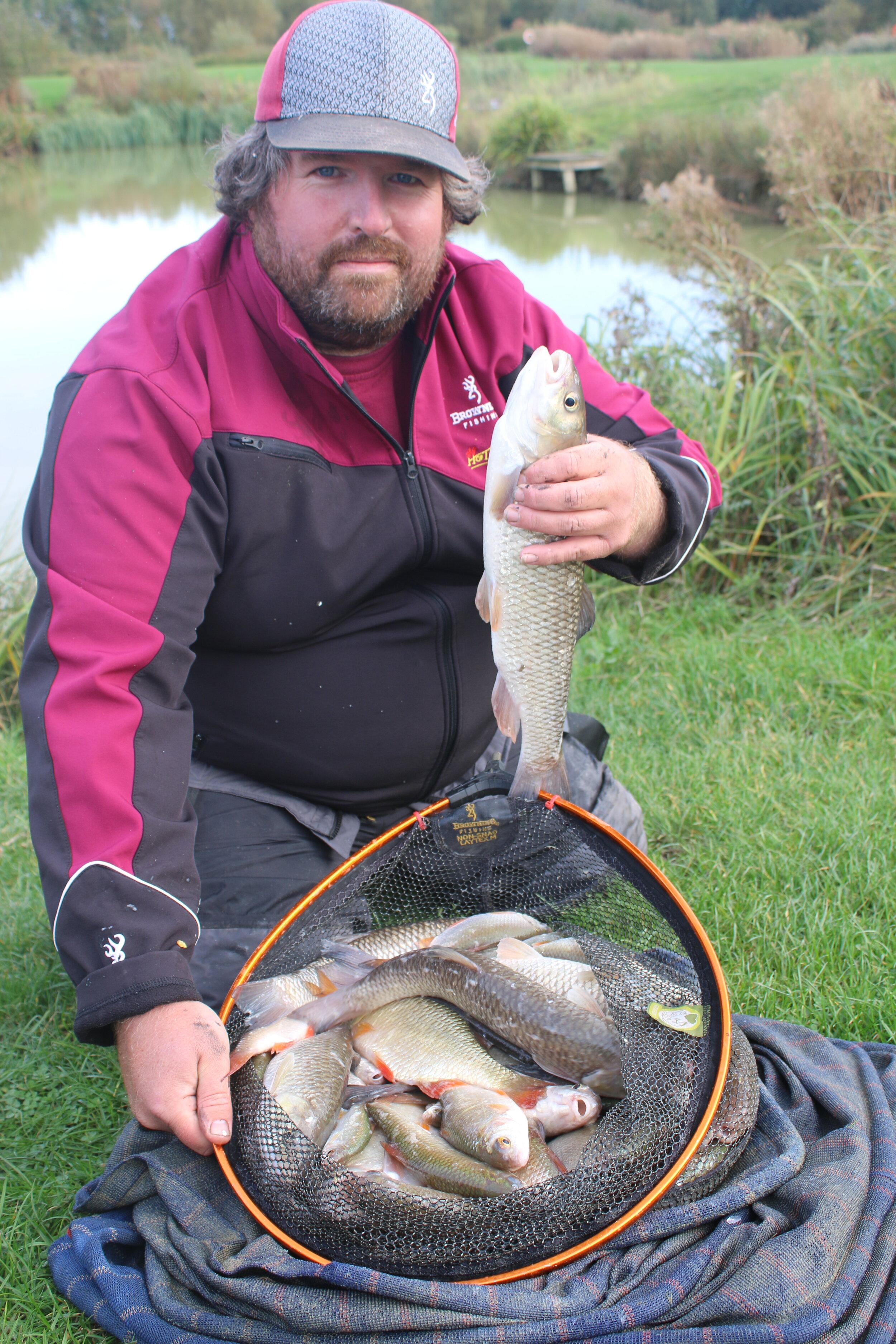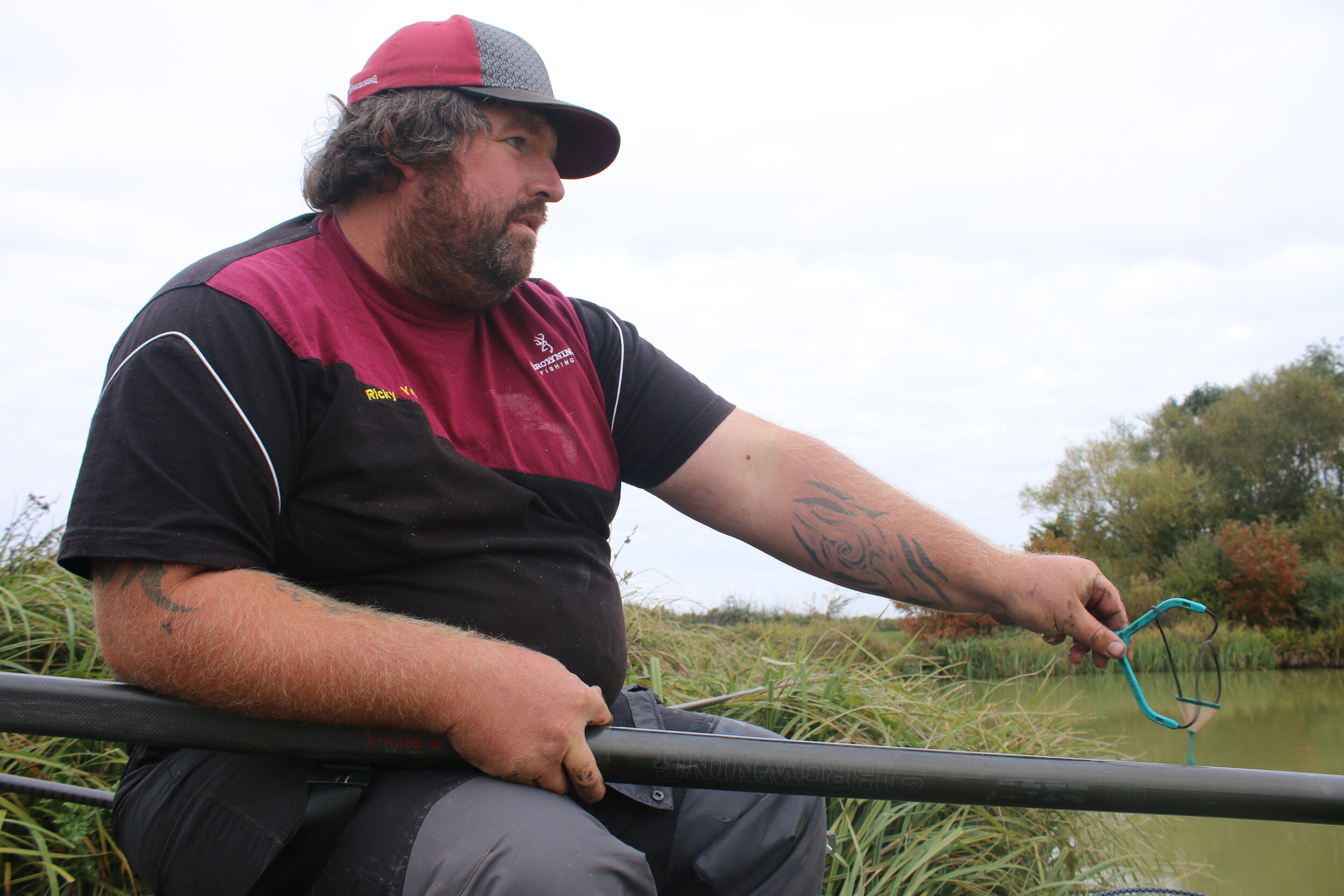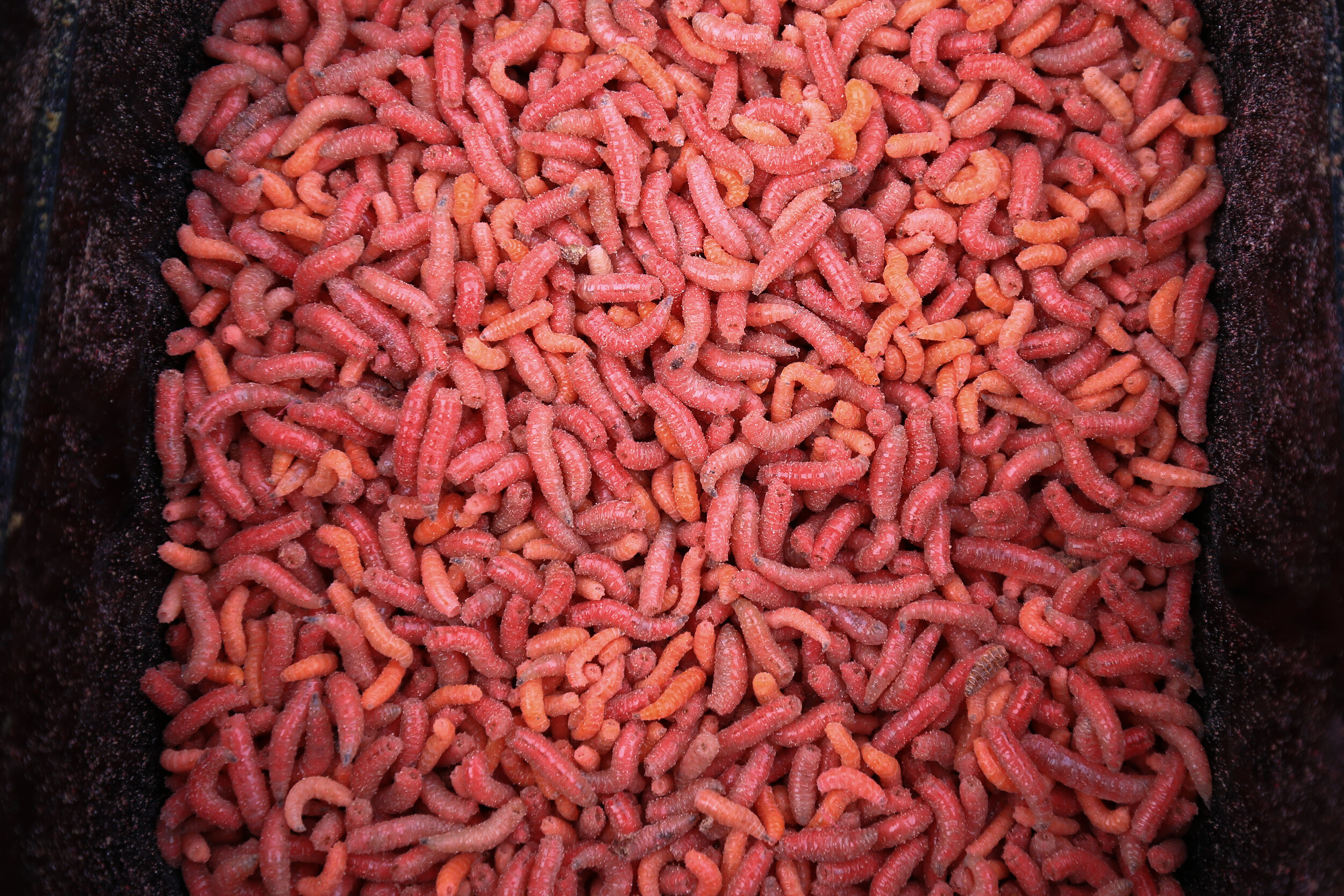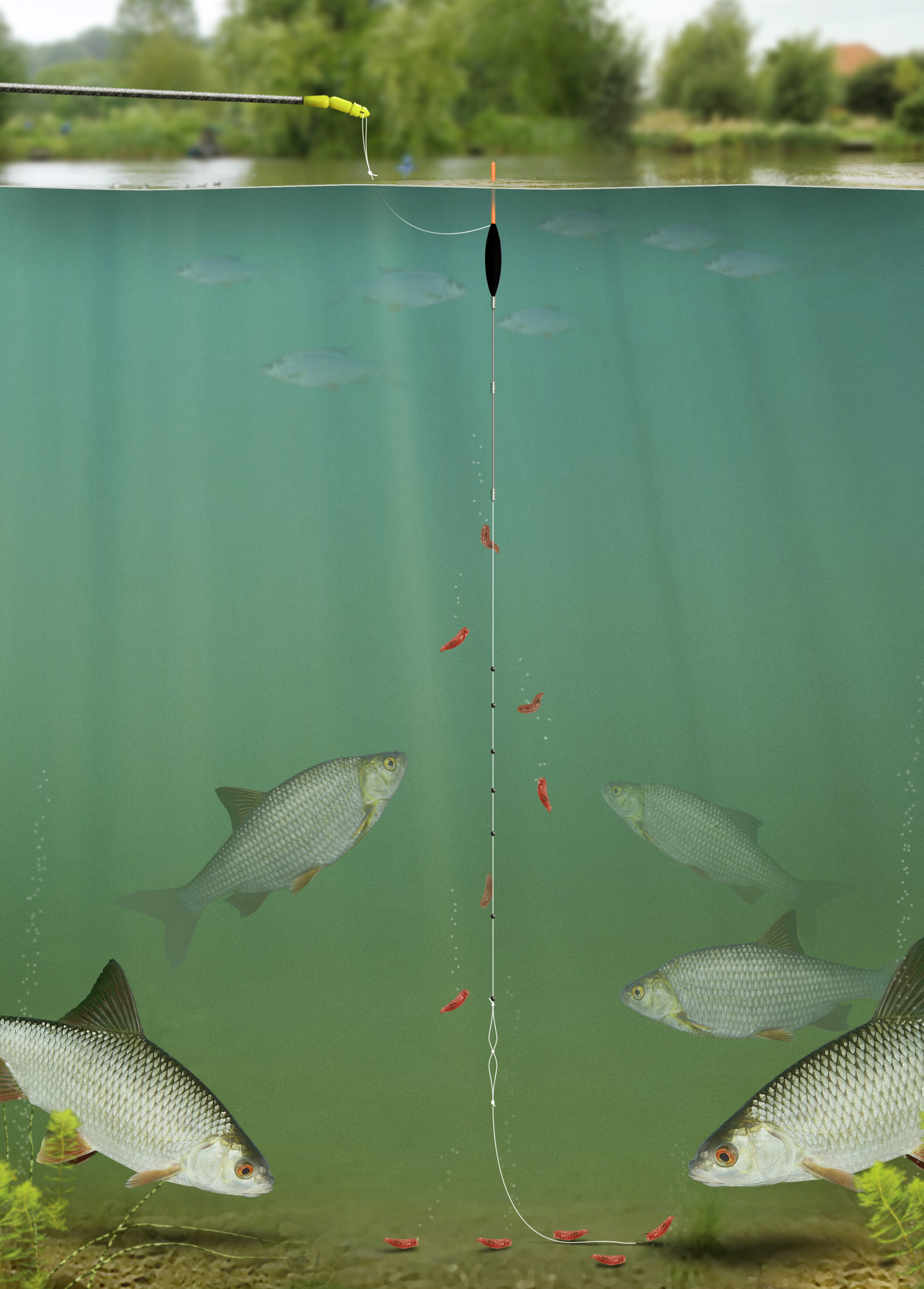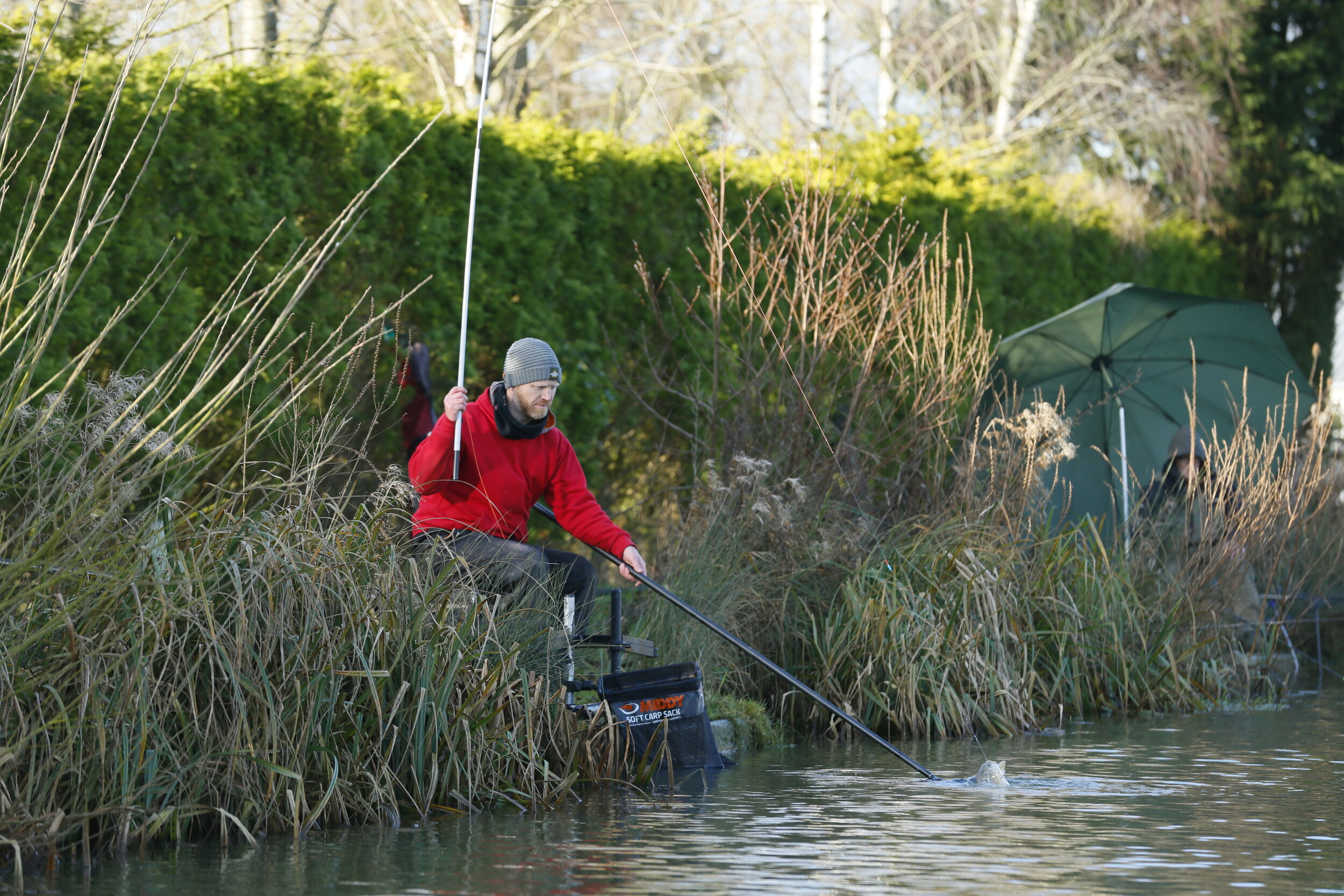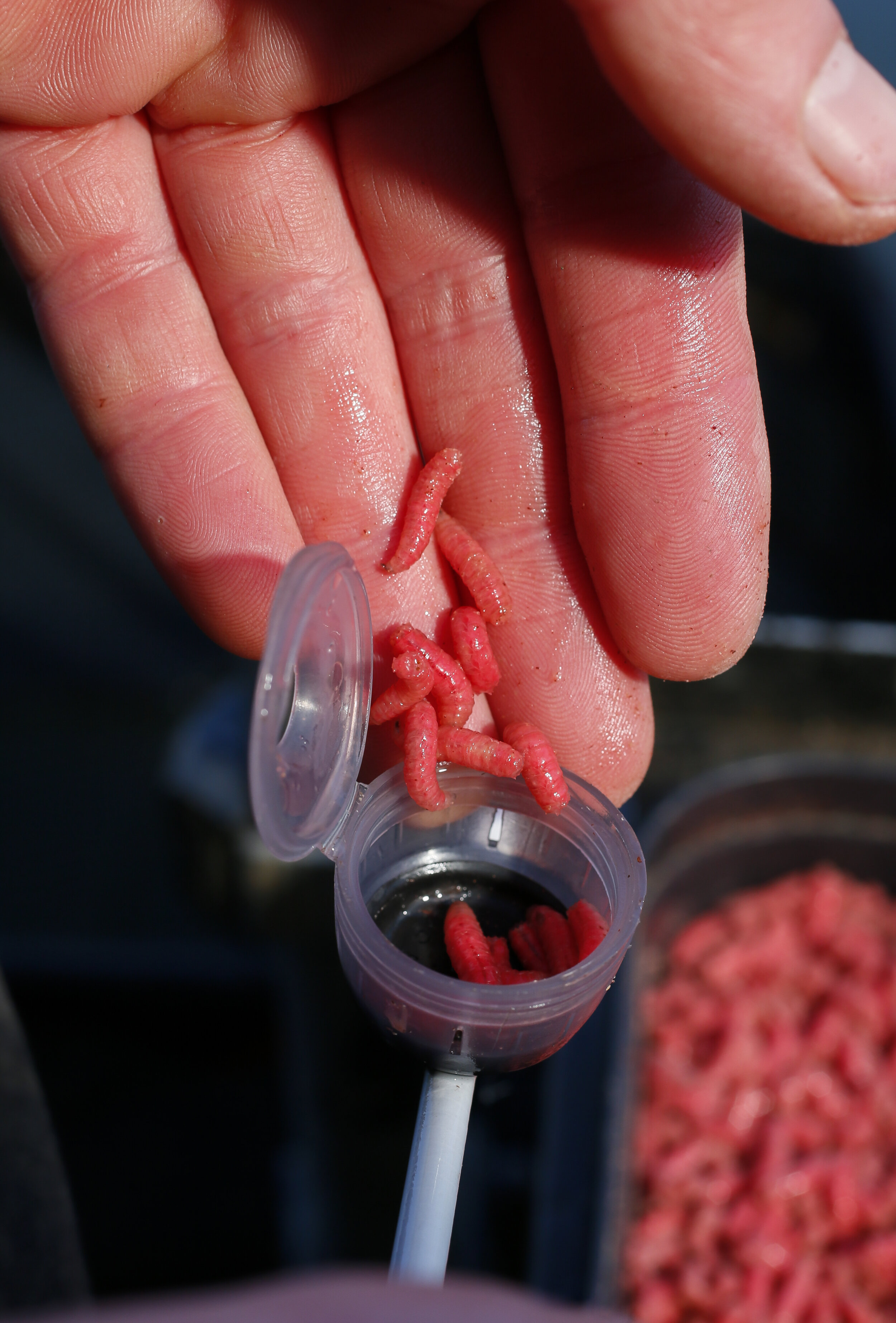Commercial Fishing Tips | Six tips to shallow up for silvers - Ricky Young
As long as the temperatures overnight and in the day stay settled, with no big drops, I’ll put my money on catching a big net of quality silvers by fishing off bottom, sometimes even properly shallow.
Fishing shallow can catch you quality nets of silvers
Here’s some tips to help you do the same…
GO FOR A LIGHT ELASTIC
Even if you hook a rogue carp, you can get it out using light elastic. The Browning Microbore orange grade I use is perfect – soft enough to land roach and skimmers without hook-pulls, but you can land a carp with a side-puller kit.
Big fish can be landed on light elastics
GREAT PRESENTATION
A light float allows the bait to fall through the water slowly and find the bigger roach. A homemade slim-bodied 0.2g float taking seven or eight No10 shot strung in the bottom half of the rig will get the job done.
A light float encourages a slow fall of the hookbait through the water
USE GROUNDBAIT
I’ll pot in three large balls of groundbait. This attracts and focuses the fish in a spot over which I can then fire casters. My mix is a split of Browning Black Roach, Quick Skimmer and Formula Fish.
Pot in groundbait to draw the fish in from the off
SWITCH TO MAGGOTS
Casters are always my choice for silverfish, but they can sometimes be too selective. Maggots are the great fall-back bait that can get a peg going again when it seems to have slowed up.
Maggots are a great change bait if bites slow down on casters
FEED A SECOND LINE
You won’t plunder one line all day, as the fish will eventually back off. This is where I have a second swim on the go, to target big roach and skimmers. I put this in at 6m but off to one side, and will only fish here on the bottom.
Feed another line to with to when bites slow up
FEED WITH A CATTY
While the weather remains mild, the fish will still be active. To catch off bottom, you need to keep loosefeeding casters. The regime is 10 casters fired in every time I drop the rig in and every 60 seconds when I’m fishing the close-in line.
Keep the feed going in
Commercial Fishing Tips | Catch more silvers on chopped worm - Steve Ringer
ALTHOUGH I think we’re past the window in the year when chopped worm works for big carp, where silverfish are concerned it’s still a vital bait to have to hand.
We all know perch love worms, but so do roach and skimmers. If I was fishing a venue with a real mix of fish in it, such as Lambsdown Lake at Meadowlands Fishery, worms would always play a part – not however, when fed on their own!
Instead, I try to combine worm with groundbait and other goodies like casters and dead pinkies. Few people can deny the pulling power of chopped worms. The juices that leak off pull fish in quickly, but this is a feed that you need to go steady with.
Feed too much and worms in cold water can put the fish off. By introducing only a small taster of finely-chopped dendra worms every time I feed on the pole, or cast a feeder, I’m in a position to work out how well the fish are responding, allowing me to increase or decrease the amount of feed.
Chopped worm is a vital bait for silvers in the colder months
RIDDLE OFF THE SOIL
I want worms soil-free. I’ll riddle off the bulk of the soil and then pop them in a tub. The worms will ball up, pushing off excess soil.
Riddle excess soil off your worms
MAKE A MUSH
How finely you chop worms is dictated by the size of fish I’m after. Big fish need a rough chop, but smaller fish need a minced-up mush.
For smaller silvers, try to create a worm mince
START WITH A PINCH
Bream love worms, but sometimes not in the cold. I’d start with just a pinch of choppie inside a ball of groundbait or in the feeder.
Just a pinch is enough to add attraction to groundbait
CHOP SOME CORN
I’m a big fan of the colour yellow for bream, so I’ll chop up some corn to add to the mix. This puts small flecks of colour into the swim.
Corn and worm is a deadly combination
Canal Fishing Tips | Should you loosefeed over groundbait? - Matt Godfrey
On the deep shipping canals of Yorkshire that I fish, loosefeeding over the top of groundbait actually defeats the point of what I’m trying to achieve. I want the fish to be firmly on the bottom, feeding on the groundbait and giving me a focal point over which to put my rig.
Firing in casters or maggots runs the risk of spreading the fish over a wider area and even coming off bottom, so I wouldn’t use a catapult at all. Instead, I’ll cup in two to four balls of groundbait, the amount depending on how many fish I feel are in the area and how good the peg is, topping up with a ball the size of a large walnut when bites fade or I begin to catch small fish.
On deep canals a groundbait only approach is the way
Commercial Fishing Tips | 5 tips for maggot feeder fishing
Once the sole preserve of river anglers chasing chub, the maggot feeder has now made its mark on commercial fisheries too – and not just for carp!
Here are 5 tips to make the most of the method…
Mix up the freebies
It’s common to feed a mix of baits when fishing the pole, so why can’t you do the same with the maggot feeder? Alongside maggots, add some fluoro pinkies and even a few casters or fish something a bit different. This also provides you with an alternative hookbait option if you’re struggling for a bite. Double maggot is the best starting bait, but switch to three pinkies from time to time to see if it improves the fishing.
A mix of maggots and pinkies can help keep the bites coming in thought conditions
Pack the feeder
Maggots will soon wriggle out of a feeder, so take a bit more time to fully pack them in on each cast to stop this happening – they’ll have no problem getting out once the feeder hits bottom! What you don’t want are maggots spilling out on the cast or as soon as the feeder hits the water. Cram as many as you can into the feeder’s body.
Cram as many maggots into the feeder as you can
Keep active for silverfish
Where silvers are concerned, moving the feeder can be a help, not a hindrance. Try casting out, leaving the feeder still for a minute and then picking the rod up and winding in, moving the rig by about 6ins. If nothing happens, repeat the process a couple of times. This movement helps the feeder empty, releasing a few more maggots into the swim. It also gives the hookbait a burst of movement, which can trigger a fish into hitting it.
Keep the feeder moving to gain extra bites
Starve them on to the hook
If your swim has a lot of fish in it, normally shown either by quick bites or a lot of indications on the quivertip, you can catch quicker by reducing the amount of maggots you’re feeding. Change to a smaller maggot feeder that holds say, 12 maggots as opposed to the 30 of a larger model and you’ll be giving the fish less choice. With fewer maggots to feed on, they should find your hookbait faster!
Less choice can mean more bites!
Long hooklengths
Fish will still be feeding off bottom at the moment, but that’s not to say you can’t catch them on the drop with the feeder. A long hooklength is essential here, typically the length of half the swim’s depth – so in 6ft of water, that means a 3ft link. This makes the hookbait fall slowly through the water once the feeder has settled, and can be brilliant for F1s and silverfish. Add a little maize meal to the maggots going into the feeder and it will put a slight cloud into the water to attract more fish into the peg.
Long hooklengths will help the slow fall of the hookbait
Pole Fishing Tips | Six feeding tips for silvers on natural venues - Josh Newman
Little-and-often is a tried and tested way of feeding for silverfish, but there are occasions in summer when a bolder approach is required.
Be bold with your feeding for summer silvers and you will catch more
Feed heavily to start
At the start I’ll throw in 14 large balls of the groundbait and leam mix. This sounds a lot, but I won’t be feeding any more of this mix, so I need a good amount to try and keep the fish in the peg.
Kick off the swim by balling it in
Top-up with more
When I think the effect of the cloud from balling in has finished, it’s time to add more feed with a pot. This is a mix of damp leam and grey leam (half a bag of damp to just 25ml of grey), plus particles.
Top-up with more feed when you think the initial balls have had their effect
Keep loosefeeding
Loosefeeding hemp is important. It not only gives me the chance to catch on it late in the day, but it also keeps on drawing fish into the swim by having something falling through the water all the time.
Steady feeding with hemp will keep fish interested
Set up Multiple rigs
Because of the cloud, I can catch fish 6ins off bottom and then switch to the deck later. One rig won’t do both jobs, so I set a couple up. Both are Sensas Avon floats with a 0.8g for fishing off deck and then a 1.25g pattern for down below.
Multiple rigs will ensure you can catch fish at all layers
Dot your float down
The less float bristle you have on show, the more bites you will hit. Trying to shot a float with small split shot is tricky, so I use micro styls. I’ll shot the float as normal, then add four or five tiny styls to leave just a speck showing.
Dot your float right down to hit sensitive bites
Try ‘Short’ elastics
In deep pegs of over 10ft, you need a strong elastic to set the hook. Running elastic through a top kit would require around a No6, which is too heavy. My solution is to use a length of No4 elastic through just the tip section of the kit.
A light elastic through just the tip section will land you more fish
A cracking net of natural water silvers
Pole Fishing Tips | Six tips to get through the tiddlers - Stu Redman
GETTING through the tiddlers to the quality fish you know are in the swim can be a nightmare!
There’s nothing wrong with a netful of little fish, but coming off the bank having caught 50lb of prime, fat roach, rudd and tench is a lot more satisfying.
Fat roach, rudd and tench are far more satisfying
Here are six tips to get through to the better stamp…
USE Big pole floats
I use a 2.5g Ian Everett float with a rugby ball-shaped body and a highly visible bristle, and group the olivette and dropper shot above the hooklength to bomb the bait down quickly.
A big float with a heavy bulk shot will help get the bait down through the smaller fish
Double up your corn
Rudd and tench love corn, so that’s the only hookbait to use – two grains on a size 14 hook. That way, if one is nicked off the hook, I’m still left with the second piece to fish with.
Two grains can withstand the attentions of small fish
Create a cloudy mix
A very wet mix that clouds the swim is deadly but groundbait alone won’t do this. To my mix I add a big squirt of Sensas IM2 Green One Shot Spray, that helps give me that long-lasting cloud up in the water.
Clouds can keep the small fish distracted
Liquidise some corn
To the groundbait I add liquidised corn blasted for 30 seconds in a blender. Before adding it to the mix I wring the corn out to remove as much water as I can to help stop the groundbait becoming too wet.
Liquidised corn is a real edge
Use a light plummet
Over-heavy plummets will spook fish, so I carry two sizes. The 30g version finds the depth to begin with, but when I need to recheck, I slip on a tiny 10g plummet that creates far less disturbance.
Smaller plummets create less disturbance
Dunk your balls
Before I feed a ball of groundbait, I wet it. Now it will stick to the lakebed and not roll away. Dunk the ball for just a few seconds and this extra water will also help it to break up that bit quicker.
Dunked balls of groundbait will stick to the lakebed and not roll away
Commercial Fishing Tips | 4 tips for a big weight of silvers - Steve Ringer
One of the joys of fishing is never knowing what you’re going to hook next.
Even on commercial fisheries this is the case. Aside from the big mirrors and commons, you’ll find masses of F1s, barbel, skimmers, tench and roach which, when targeted correctly, can give you a brilliant day’s sport.
To catch them consistently, though, and to try and avoid the carp, you need a different approach. Light rigs fished through the water, small natural baits and regular feeding – plus trying to target areas away from the carp – are the key factors. Once you get these right, the bites will be quick in coming and you can really start bagging.
Amount to feed
Feed a dozen casters at a time, upping this if small fish are a problem. Casters make a noise hitting the water, bringing fish off the bottom.
Hookbaits
A single caster will get bites at the start, but switch to double if you want to catch something a bit better. Use the dark-coloured shells.
Elastics and floats
A Blue Hydrolastic is soft enough for silvers, but has enough power to tame F1s. Use a light float such as a 4x10 or 4x12 F1 Slim pattern.
Terminal tackle
A size 16 Guru F1 Pellet Barbless hook is the ideal hook, matched to a 6ins hooklength of 0.12mm or 0.14mm Guru N-Gauge line.
Commercial Fishing Tips - How to keep bites coming in the middle of the day - Des Shipp
When bites dry up and things get slow in the middle of the day, don’t just sit there waiting for something to turn up. Look no further than fishing off your rod-tip or on a top kit on the pole in front of you.
Action doesn’t have to be slow in the middle of the day - stay active!
Rig up with a size 16 hook and a 4x14 pole float or a small 2BB waggler, feeding maggots or casters.
A typical Stillwater roach rig perfect for margin work
This will catch mainly silvers, but something bigger can turn up too.
Steady feeding with maggots close in can draw all sorts into the peg
I’ll feed a dozen maggots by hand here every five minutes and when my other lines slow up, switch to this one. You may catch all day here or it may only last 30 minutes.
Commercial Fishing Tips | Catch anything on maggots - Rob Wootton
Waiting for a few carp to have a chew in the depths of winter often ends with very little in the net to show for your efforts.
This is why fishing a lake with a good mixed stock of fish gives you the best possible chance of a busy day’s sport.
Every commercial fishery offers much, much more than just carp. It’s almost certain to be home to roach, bream, probably perch and even ide too.
What’s more, all these species are more than willing to feed in the cold.
Catching a netful from fisheries like these couldn’t be easier, and as far as bait is concerned it’s a cheap outing into the bargain. A tenner should buy all you need.
Two pints of maggots and a little groundbait is all you require for an exciting and interesting session in which you can never be certain just what’s going to be on the end when the float next goes under.
Why maggots are king
Why take only maggots? Well, they catch everything and are nowhere near as selective as pellets or sweetcorn.
You seem to catch for longer and more consistently with them. Two pints of reds and whites will be enough, and you may even have some left over at the end for another session.
Rotate your lines
Plugging away on one single swim will only end in it slowly dying a death. You need to have other options and rotate between them to get the best out of the day. This isn’t as complicated as it may seem.
My main swim is on the long pole at 11m to 13m. That’s a comfortable distance, but I do try to find any changes in the depth, such as deep hole or bar. These are very attractive to fish, even though they might not sound like much to us!
There will be a second line at short range, perhaps 5m or 6m out, which I’ll save to fish in the last two hours of the day.
I’ll only feed here roughly half an hour before I want to fish this line in order to get the maximum impact of feeding maggots in this new area.
‘Canal’ rigs
Other than the odd carp, most of the fish you’ll catch on maggots will be small enough to land on quite light tackle.
I recommend a size 18 hook to a hooklink of 0.08mm diameter and a mainline of 0.14mm. Provided your pole elastic is soft enough, there’s little danger of it getting broken by a fish. Shotting is also very delicate, using No11 shot. Space these apart all the way across the rig, so the single dead maggot bait falls very slowly.
Commercial Fishing Tips | Get your groundbait right for winter silvers with Adam Wakelin
Read many a typical match report and you’ll see anglers say ‘I put in six balls of groundbait on the long pole line’.
This is only telling half the story, though, because it raises a lot of questions if you really want to get down to the nitty gritty.
For example, what was the groundbait? What colour was it? How big were the balls? What was in them? The answers to these can be wide-ranging depending on the venue, the head of fish, water colour and temperature – and that’s just for starters.
Groundbait is essential for silver fish at any time of year but in winter it’s vitally important to use it correctly. Getting it wrong can wreck a swim before it has a chance to get going, so this week I’m taking a look at how throwing in a few balls for roach and skimmers can vary so much…
Ball it in!
The best way to get a lot of bait into a swim fast is to throw in several large balls, known as ‘balling in’. You’ll see this a lot on big, deep, natural venues where small fish are the target. A massive hit kicks the swim off quickly, but the big decision to make is how many balls to throw in.
There’s little point scrimping in this situation so I’d go for 10 or 12 large balls and throw them in on the pole line over an area a metre square. This also makes a lot of noise to pull fish in, but the groundbait has to be on the wet side to hold together and not break up in mid-air.
Loose groundbait
There are times when cupping in groundbait loose and not squeezing it into a ball is better, and this is in very shallow water of 3ft or less. I find that a loose mix gets things underway much faster, as the groundbait is already broken down. It is important the mix is wet, though, so it has the weight to get down quickly and stay put on the bottom without any danger of drifting off.
Adding goodies
Groundbait alone is not enough to keep the fish in the swim, and because you want them to eat the hookbait, you have to add the same into the feed. For me that means dead pinkies and dead maggots and casters where silver fish are concerned. These will be my three main hookbaits.
In the opening balling in of feed there’s next to nothing added, and it all goes into those rich balls that are potted in.
On a hard day this amount may be just a sprinkling, but on a mild day with colour in the water I’ll pile it in, packing each ball to the maximum.
Dead pinkies are especially good as they are soft, highly visible and small enough to get the fish really grubbing about.
Ball size
I’ve already talked about the opening balls being proper two-handed jobs, but any top-up should be much smaller. This is normally a single-handed squeeze to produce something that resembles a sausage.
Topping up is done to get the fish back to where you want them so the groundbait is just a carrier for the particles, which is what the fish will be hunting for.
Loosefeeding over the top
There are times when groundbait alone isn’t enough to keep catching – firing in loosefeed over the top keeps the swim simmering along nicely.
Picking up the catapult gives you two bites of the cherry, in that you can get bites over the groundbait but also as the hookbait falls in amid the loosefeed at a range of depths.
How much and how regularly you feed is governed by how many fish are in front of you so, in a solid peg, I may even ‘double pouch’ (fire in two lots every time). But as a rule it’s just the one load and only 10-20 maggots or casters each time. Maggots are good for a range of fish sizes but quality counts in a match, and I’d always go for casters to find a better stamp of roach or skimmer.
What about loosefeeding on its own? If I knew the fish were already there and I didn’t need to add any groundbait at the start, then this would be viable, but I always feel groundbait gives you a quick start and pulls fish in immediately, whereas pinging bait in is more of a slow burner.
Pot in a richer groundbait
The pole pot comes into play once I’ve thrown those big balls in. That’s because the opening hit gets fish into an area, but I then want them to move and concentrate on the spot that I’m going to be putting my rig over.
Five more balls go in with the pot in the same place, but these are ‘richer’ in that they hold more particles.
All things being equal, the fish should come to the balling in noise and then find those rich balls and stick around. When they do back off, they won’t go far and it only needs another rich ball potted in to bring them back.
Potting is also advisable on very hard days when bites will be at a premium and you need to wring every last fish out of the peg.
I will also use a pot as opposed to balling if there are a lot of pike about, as the balling pulls small fish in and the pike follow.
River Fishing Tips | How to catch silvers after the floods
Top matchman Dan Squire reveals how to catch after the floods…
Floods are no good for anyone, but most of all the river angler who will have been sat at home twiddling his thumbs and waiting for the waters to finally recede.
It’s frustrating and annoying, but the one crumb of comfort is the knowledge that when levels do return to normal, the fish will be ravenous, having been unable to feed properly for weeks on end. That means a bumper day on the bank is in prospect!
Rivers will still be holding some colour, and provided the weather is mild, all species will feed – big barbel and chub for the specimen hunter, roach for the pleasure angler. A double-figure net is the minimum target that they should be aiming for.
The best way to catch them in coloured water is without a doubt a groundbait attack, throwing in an opening salvo of balls packed with loose offerings and then running a pole rig over the top. Roach will home in on the groundbait and mill about over it for hours, and this is when you can really plunder them.
Big rivers like the Wye and Thames usually grab the headlines for big nets but much smaller waters are also stuffed with roach.
It was on one of these, the River Parrett in Somerset, where Sensas star Dan Squire was to prove what river fans have been missing out on for so many weeks…
Go for the pole
“Anyone who lives on the doorstep of the Parrett knows it is a phenomenal venue for roach,” explained Dan. “I’ve had loads of double-figure catches, despite the river not looking all that good at first glance. However, it has a good depth down the middle even though it’s not that wide, and that makes it ideal for fishing the pole.
“The stick float can work when the river is running hard, but for an average flow, nothing more than running a rig down over groundbait will bring plenty of bites,” he added.
“The pole offers a much neater presentation, and accuracy too, allowing you to fish right over the groundbait every run through.”
Feeding
“I’ll begin by cupping in two big balls of groundbait holding casters and, after that, I will loosefeed if the flow allows,” revealed Dan.
“The mix is 50/50 Sensas Roach Noire and Gros Gardons Noire, which is very sticky and able to hold a lot of casters in each ball. After this I fire in around 30 casters each run through.
“This will draw fish from upstream but also let me run the float past the groundbait to catch further down the peg where those casters will be landing.”
Positive floats
“On rivers with lots of fish to go at and a good depth, you need to fish reasonably positively in terms of floats. One between 1.5g and 2.5g will deal with most river conditions,” Dan explained.
“A Sensas Jean François is the classic river pattern and it only needs an olivette and couple of dropper shot.
“This type of float also has enough of a body to let me slow the rig down against the flow if I need to, without the presentation being affected.”
End tackle is relatively fine, though. This, given the target species, is no surprise. Dan goes for 0.08mm or 0.09mm Sensas Feeling as a hooklink to a size 18 Sensas 3405 hook to allow him to fish with either maggot or caster on the hook. Caster is the preferred bait as it always produces a better stamp of fish, and matches what he is feeding.
Keep in touch
Roach are famed for moving about in a river swim, especially if you are loosefeeding, so if the bites suddenly drop away Dan’s solution is to add a pole section to go either further across the river or down the peg.
It’s amazing the difference this can make, and often produces a bigger fish or two into the bargain.

